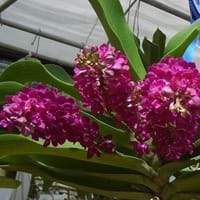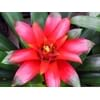Life Span
Perennial
Perennial
Origin
World/Pandemic
South America
Types
Rhynchostylis gigantea (Red), Rhynchostylis gigantea (Chang Ply type)
Aechmea 'Albright Red', Aechmea 'Amazonense', Aechmea 'Amazonia'
Habitat
Coastal Regions
tropical environments
USDA Hardiness Zone
13-15
10-15
Sunset Zone
H2
H1, H2, 22, 23, 24
Habit
Clump-Forming
Rosette/Stemless
Flower Color
White, Lavender, Violet, Plum
Yellow, Red
Flower Color Modifier
Bicolor
Not Available
Fruit Color
Not Available
Blue, White
Leaf Color in Spring
Green
Chocolate, Silver
Leaf Color in Summer
Green
Chocolate, Silver
Leaf Color in Fall
Green
Chocolate, Silver
Leaf Color in Winter
Green
Chocolate, Silver
Leaf Shape
Long Linear
Spine-edged leaves
Plant Season
Fall, Winter
Spring, Summer, Fall, Winter
Sunlight
Partial Sun, Partial shade
Full Sun, Partial Sun, Partial shade
Type of Soil
Not Available
Sand
The pH of Soil
Not Available
Acidic, Neutral, Alkaline
Soil Drainage
Well drained
Well drained
Bloom Time
Early Fall, Fall, Late Fall, Early Winter
Early Summer, Summer, Late Summer
Tolerances
Not Available
Not Available
Where to Plant?
Container, Ground, Pot
Container, Ground, Pot
How to Plant?
Divison
Stem Cutting
Plant Maintenance
Medium
Medium
Watering Requirements
Keep ground moist, Over-watering can cause leaf problems or root diseases
Keep ground moist, Keep the ground moist but not water-logged
In Summer
Moderate
Lots of watering
In Spring
Ample Water
Moderate
In Winter
Average Water
Average Water
Soil pH
Not Available
Acidic, Neutral, Alkaline
Soil Type
Not Available
Sand
Soil Drainage Capacity
Well drained
Well drained
Sun Exposure
Partial Sun, Partial shade
Full Sun, Partial Sun, Partial shade
Pruning
Remove dead branches
Cut away fading foliage, Cut or pinch the stems, Remove damaged leaves, Remove dead branches, Remove dead flowers, Remove dead leaves, Remove dead or diseased plant parts
Fertilizers
Fertilize once a week in winter
All-Purpose Liquid Fertilizer, High-phosphorous fertilizers used, light feeding and water solubles, slow-release fertilizers
Pests and Diseases
Not Available, Red blotch
Red blotch
Plant Tolerance
Not Available
Not Available
Flower Petal Number
Single
Single
Foliage Texture
Coarse
Bold
Foliage Sheen
Matte
Matte
Attracts
Not Available
Hummingbirds
Allergy
Not Available
Not Available
Aesthetic Uses
Beautification, Bouquets, Showy Purposes
Showy Purposes
Beauty Benefits
Not Available
Not Available
Edible Uses
No
Insignificant
Environmental Uses
Air purification
Air purification
Medicinal Uses
Not Available
Not Available
Part of Plant Used
Flowers
Flowers
Other Uses
Oil is used for aromatherapy
Used as Ornamental plant
Used As Indoor Plant
No
Yes
Used As Outdoor Plant
Yes
Yes
Garden Design
Container, Feature Plant, Houseplant, Mixed Border
Container, Feature Plant, Houseplant, Tropical
Botanical Name
RHYNCHOSTYLIS gigantea
AECHMEA chantinii 'Black Chantinii'
Common Name
Orchid, Rhynchostylis
Aechmea, Black Aechmea, Black Chantinii Bromeliad
In Hindi
कोपु फूल
Black Aechmea
Plant
In German
Rhynchostylis Gigantea
Schwarz Aechmea
Pflanze
In French
Rhynchostylis Gigantea
Noir Aechmea
Plante
In Spanish
Rhynchostylis Gigantea
negro de Aechmea
Planta
In Greek
Rhynchostylis Gigantea
μαύρο Αιχμέα
Φυτό
In Portuguese
Rhynchostylis Gigantea
preto Aechmea
Plantar
In Polish
Rhynchostylis Gigantea
Czarny Aechmea
Roślina
In Latin
Rhynchostylis Gigantea
niger Nidularium
planta
Phylum
Tracheophyta
Vascular plant
Class
Liliopsida
Liliopsida
Family
Orchidaceae
Bromeliaceae
Genus
Rhynchostylis
Aechmea
Clade
Angiosperms, Monocots
Angiosperms, Commelinids, Monocots
Tribe
Not Available
Not Available
Subfamily
Not Available
Bromelioideae
Number of Species
Not Available
Difference Between Rhynchostylis Gigantea and Black Aechmea
If you are confused whether Rhynchostylis Gigantea or Black Aechmea are same, here are some features about those plants to help you choose better. Many people think that these two plants have the same characteristics, but one can see Rhynchostylis Gigantea and Black Aechmea Information and learn more about it. Fertilizers required for proper growth of Rhynchostylis Gigantea are Fertilize once a week in winter, whereas for Black Aechmea fertilizers required are All-Purpose Liquid Fertilizer, High-phosphorous fertilizers used, light feeding and water solubles and slow-release fertilizers. Hence, one should know the basic difference between Rhynchostylis Gigantea and Black Aechmea if you are planning to have them in your garden to enhance its beauty.
<
Flowering PlantsImportance of Rhynchostylis Gigantea and Black Aechmea
Want to have the most appropriate plant for your garden? You might want to know the importance of Rhynchostylis Gigantea and Black Aechmea. Basically, these two plants vary in many aspects. Compare Rhynchostylis Gigantea and Black Aechmea as they differ in many characteristics such as their life, care, benefits, facts, etc. Every gardener must at least have the slightest clue about the plants he wants to plant in his garden. Compare their benefits, which differ in many ways like facts and uses. The medicinal use of Rhynchostylis Gigantea is Not Available whereas of Black Aechmea is Not Available. Rhynchostylis Gigantea has beauty benefits as follows: Not Available while Black Aechmea has beauty benefits as follows: Not Available.
Compare Facts of Rhynchostylis Gigantea vs Black Aechmea
How to choose the best garden plant for your garden depending upon its facts? Here garden plant comparison will help you to solve this query. Compare the facts of Rhynchostylis Gigantea vs Black Aechmea and know which one to choose. As garden plants have benefits and other uses, allergy is also a major drawback of plants for some people. Allergic reactions of Rhynchostylis Gigantea are Not Available whereas of Black Aechmea have Not Available respectively. Having a fruit bearing plant in your garden can be a plus point of your garden. Rhynchostylis Gigantea has no showy fruits and Black Aechmea has no showy fruits. Also Rhynchostylis Gigantea is not flowering and Black Aechmea is flowering. You can compare Rhynchostylis Gigantea and Black Aechmea facts and facts of other plants too.





